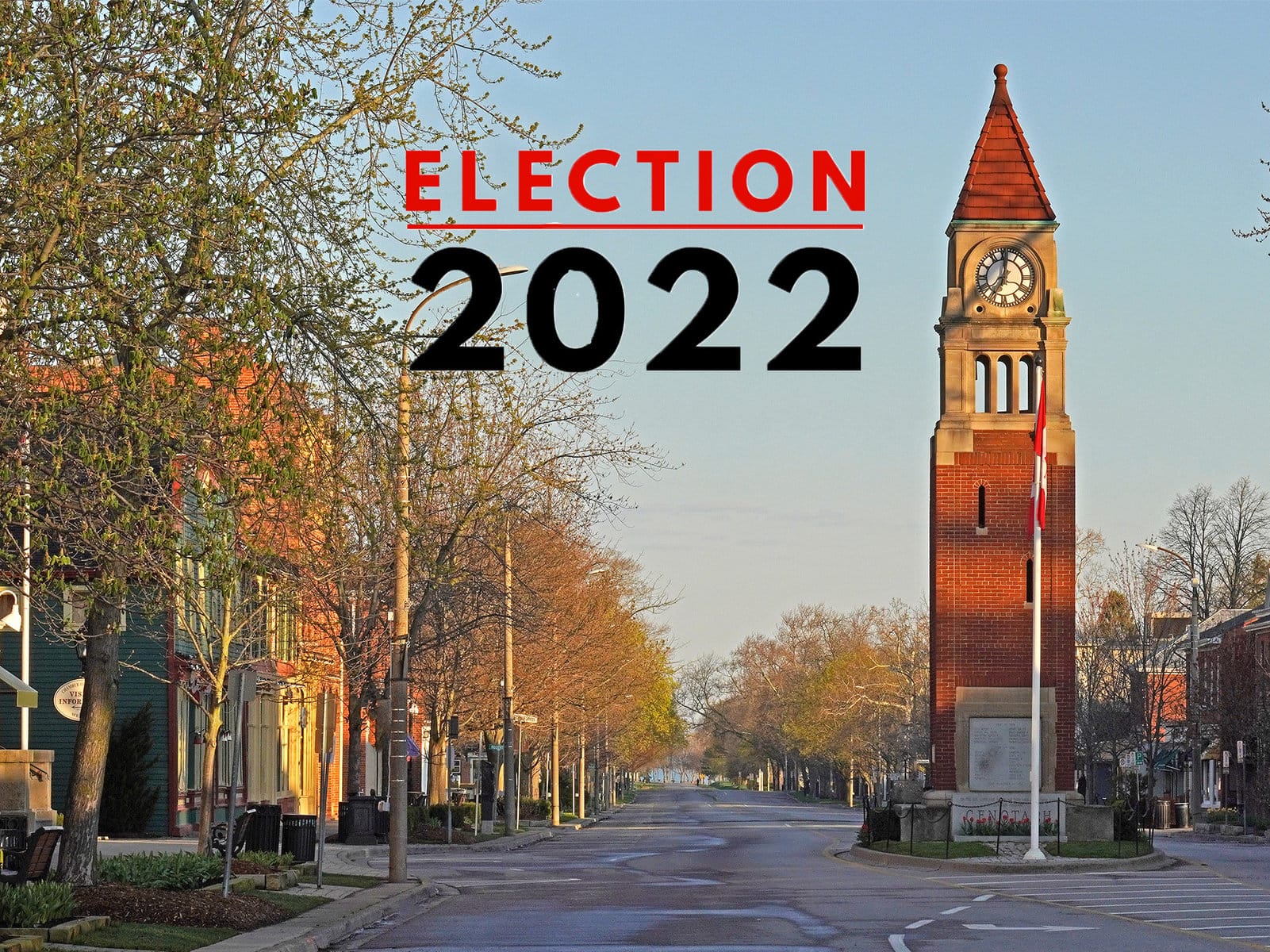Disero, Goettler and Zalepa offer their views on protecting NOTL’s unique character
Over the past few weeks, I had conversations with each candidate for lord mayor.
As regular readers of the Arch-i-text column might expect, the focus was each candidate’s view, position and platform generally related to development in Niagara-on-the-Lake.
We began the conversation by asking candidates to share their understanding of the town’s people, what comprises its cultural heritage landscapes and what their vision is for the future.
Betty Disero noted NOTL is comprised of five distinct and unique settlement areas and the agricultural community, each of which has evolved from a separate historical context.
It is her sense that the citizens have a common shared vision for the town and she feels St. Davids, Virgil and Glendale should each have a “village centre” similar in function to the park in the heart of Queenston.
Speaking to Old Town, Disero cited her intention to expand the heritage district, conduct character studies to identify “sensitive areas” and the use a negotiated agreement with the region that allows “shifting of density” among the five areas (so higher density in one area allows for lower density in another), while still achieving provincial intensification targets. It is also her intention to address the agricultural irrigation requirements by having irrigation classified as infrastructure.
Vaughn Goettler describes our distinct villages and agricultural sector as the “back-bone” of NOTL. He sees each community as having its “own needs and situation” and infers through examples that he wishes to preserve the integrity of each while providing tailored solutions to their needs.
He said preservation of the existing town form and context should be the priority, not attempting to find methods to fulfil provincial mandates that are clearly out of keeping with the town’s unique character.
While he does not take a position on expanding the heritage district, he supports the maintenance of unique heritage assets and characteristics of NOTL. And he intends to win UNESCO World Heritage Site recognition for the town to provide a federal umbrella in the protection of cultural, natural and historical attributes.
Gary Zalepa also sees the town as a “collection of unique communities,” a mix of neighbourhoods, settings, built forms, unique property structures and green space conjoined by agriculture. It is his intention to begin a process of understanding what is important to the entire community and utilize that to inform the development of a vision statement to provide future overarching direction for council decisions.
Zalepa said he wants to expand the existing heritage district, even if those areas are located outside Old Town. On cultural heritage landscapes, he does not believe such should be “stuck in time,” feeling that showing evolution over time is vital to offer a window into both the past and present.
Contextual approach
Disero’s approach would include the option to shift densities between districts, the institution of contextual zoning and rigorous enforcement of existing bylaws. Further, she would consider the development of a bylaw to limit the maximum square footage of a new build based on the size of the lot.
In addition, the results of the ongoing zoning bylaw review will be used to identify existing gaps that need to be corrected.
Goettler wants to ensure all existing bylaws are consistently followed and enforced while introducing an accountability review process. Further, he would bring in contextual zoning to ensure streetscapes and neighbours are respected. Paramount on this would be to negotiate with the province an agreement that identifies NOTL as a unique community, thereby underwriting lower density targets and higher levels of local oversight on development.
Zalepa would start by studying why contextual zoning did not work last time, how it can be made to work and subsequently institute it. He would establish clear “goal-posts,” expectations for both infill and new developments.
He wants the official plan approved ASAP and intends to use public forums, guided by a town vision statement, to determine the parameters for how to use available or potential available land assets (like the land tracts around the golf course in St. Davids).
Finally, he would augment (or develop) more detailed standard operating procedures in the town.
Design review guidelines
Disero is open to considering a community planning permit system (which encompasses design guidelines) but only after bringing in contextual zoning, closing gaps exposed by the current bylaw review, and expanding the heritage district in order to control “over-building” (essentially attempting to use existing process before considering a global solution).
She also wants to “put more teeth” into the municipal heritage and urban design committees’ decision-making.
Goettler declares he supports design guidelines and a precedent-based system, both of which follow his platform on the requirement to institute clearly defined expectations and accountability in the management of the town’s business.
Zalepa supports design guidelines and feels there has been “some dysfunction” in urban design committee decisions in the past few years, noting the differences between early developments in St. Davids compared to those of more recent years.
He likes the concept of a precedent-based archival system for staff recommendations and central to decisions arrived at by both the municipal heritage and urban design committees to eliminate a one-off approach while introducing defined prescriptions and higher accountability. He would also initiate a review and update of the existing four-decade-old heritage guidelines.
The planning process
There is a widely held perception that the planning process for development is applied differently in different areas of town.
Disero replied that zoning bylaws do vary between each “residential zone” (approved by the OMB in 2012), and said council had issues with that idea and had ordered the review of existing bylaws. The intent of this is to change existing bylaws to better reflect what councillors “want to see in all areas of the town.”
Goettler would ensure existing bylaws and guidelines are evenly and equally applied across town. Further, he wants bylaws/guidelines clearly worded and consistently understood.
Finally, he reinforced the importance of establishing with the province an agreement that NOTL is a unique community and requires greater levels of local control to manage its character.
Zalepa wants more effective use of urban design guidelines and noted each community in town is “somewhat different.” To respond to those differences the guidelines need to reflect the variations. He would consult with “experts in the field” to determine the viability of this segregated approach.
Minor variance limits
Disero said “minor should be minor,” but the rules the committee of adjustment must follow are set by the province. She wants to sit down with the planning department and new committee to develop a clear understanding of how a minor variance is defined in legislation and write a clear statement of what “minor” is. She said it might be necessary for council to handle all variance applications until this is done.
Goettler also wants a clear definition of what constitutes minor expressed in a percentage (he suggests something in the range of 10 to 15 per cent). He stressed this definition should be limited by the requirement for contextual architectural expression relating to the streetscape.
Zalepa said he wants “clear prescriptive guidance” on what constitutes minor. He also pre-consultation with the community prior to staff developing their recommendation for an application so the report reflects public sentiment.
St. Davids roundabout
Disero said a roundabout would have an adverse impact on the centre of the village and an alternative solution is essential to preserve the corner’s historical significance. She said implementing the new Transportation Master Plan would discussions on the roundabout (among other things).
Goettler said a roundabout poses a threat to the integrity of the village and will increase the flow of traffic, thereby posing a challenge, particularly to children and seniors, crossing the road. Instead, he suggests using intelligent traffic lights to largely accomplish the same thing.
Zalepa said the process the region followed was thorough and thoughtful, and it should be supported to its conclusion. He said he “is not married to the outcome of the process” and if, at the conclusion, community sentiment is that it will not work for them or it can be proven that the roundabout will damage the sense of village, he will not support it.
Preserving
NOTL’s character
Each candidate was asked how they would approach working with the region and the rovince to preserve NOTL’s unique character.
Disero said “one of my proudest achievements” is the negotiated agreement allowing for shifting density as representative of her work with the region and province. She wants to maintain open lines of communication with both upper levels of government.
Goettler said it is “imperative” to establish a “special relationship” with the province and he says the province’s consideration of amalgamation shows this does not yet exist. He also wants an influential relationship with the region that reflects the town’s tax contribution.
Zalepa said the lord mayor needs to be the “chief advocate for council’s desires” and direction at both the region and the province. And the mayor must be “the bridge to the stakeholders in the region, the other municipalities, the province and the feds.”











